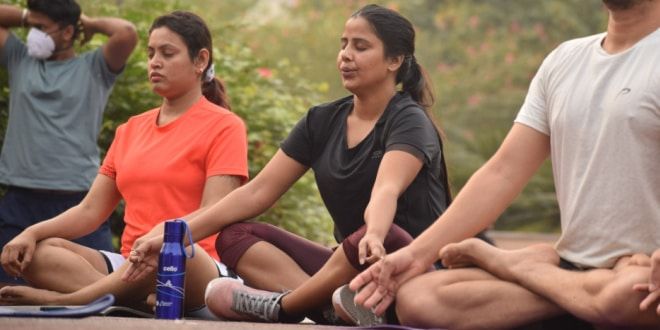While we know that the Whole30 can be hard, it’s also a form of self-care. It’s an opportunity for you to connect more deeply with your food, your body, and your emotions. The ancient Indian practice of yoga, including movement, breathwork, and meditation, can support you in your Whole30 and Food Freedom journey by helping you to access even greater wellbeing and presence in your life.
Read on to learn more about what yoga is and how yoga can support your mental health and digestion, including yoga poses for digestive health and an eating meditation. Spoiler alert: They’re game-changers.
What is Yoga?
We asked Cynthu Muthusamy, a first generation American from South India, to share with us a brief overview and definition of yoga.
Yoga is a spiritual tradition that began in ancient India. Its origins and development have been woven into an intricate fabric along with ayurvedic medicine and Indian culture. The word yoga is a Sanskrit word, which translates to union or yolk. In western practices, we often think of yoga in terms of strength and flexibility; the physical poses (asanas) and accompanied breathwork (pranayama), although there are 8 aspects (called “limbs” ) of yoga in total, including meditation.
Yoga teaches that each individual is merely one facet of this gem that is existence. When we feel a state of harmony and bliss through yoga, we may be able to sense a state of connection between the mind, body, and spirit. In this state, we are also given the opportunity to expand our energetic body and feel everything that exists as one, or “in union.”
Yoga for Mental Health and Digestion
Liilu Hansen, Whole30’s Senior Executive Assistant, is an E-RYT 500 yoga teacher and anatomy educator. In this section, she explains how digestive health and mental health are related and shares 5 yoga poses for stress relief and digestive health.
When was the last time you actually felt hungry, or noticed you were full to satisfaction when eating? These cues come from a delicate release of hormones which doesn’t happen if we are stressed or on high alert. When the brain perceives danger—when we feel stressed, anxious, overwhelmed— digestive processes slow down or may be temporarily disrupted. Imagine if you were needing to escape danger, you wouldn’t have time to sit, eat and properly digest food. Chronic stress can lead to digestive issues like diarrhea, gas, and constipation.
On the other hand, when we are calm and feel safe and peaceful we are in a parasympathetic state which is also called the “rest and digest” state. Here the brain recognizes there is time to eat and can help regulate and improve digestion. Engaging in activities that relax us is vital to restoring our nervous system to this “rest and digest” state.
It’s very common for our digestive health to mirror our mental health. This is why yoga can be a helpful tool to aid digestion. Yoga encourages breathing, stillness, and coming into the present moment, which is incredibly calming to the mind. Even just a few deep breaths can start to guide us out of anxiety and into a tranquil head space. Gentle yoga movements such as the ones recommended below also aid with the flow of food and fluid as it moves through our digestive tract. You can start to incorporate these yoga poses every day.
Integrating yoga poses into your Whole30 program may help to maximize the benefits of your Whole30 by providing even more support for your digestion, blood sugar levels, quality of life, and mental health.
5 Yoga Poses for for Mental Health and Digestion
Seated Twist
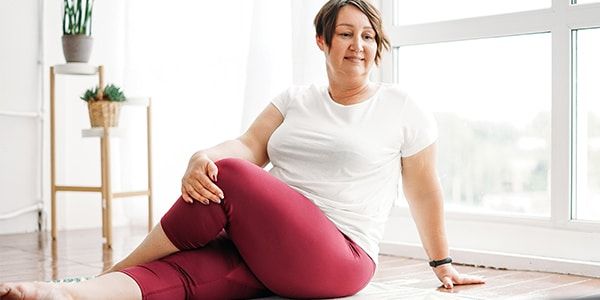
Sit upright on the floor with your legs extended. Put a rolled up towel under your knees if you experience any knee pain. Crossing your right leg over your left, place your right foot on the floor on the outside of your left thigh. As you exhale, twist your torso toward your right leg, placing your left hand or elbow on your right knee. Breathe deeply here feeling the breath all the way down into your belly. Twisting poses put healthy pressure on your intestines and colon helping with the flow of food and fluid through the digestive system. Stay on the right side for 5-10 deep breaths and then switch legs and twist to the left.
Reclined Twist
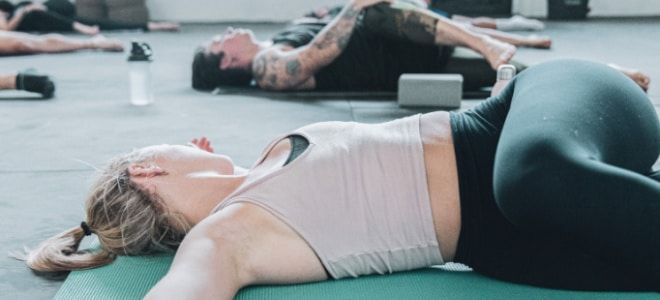
Similar to the Seated Twist, this pose is great for encouraging movement in our digestive system. By doing it on the ground we eliminate the need to hold ourselves upright, relieving any tension and can fully relax into it. It feels amazing. Lie on your back, bring your knees to your chest and pause here. Pull your knees as close to your chest as possible, breathe down into your belly and feel the pressure of your belly against your knees. This pressure, once relieved, can help flush fluids and gas through the colon. Next take both knees to the right and let them fall to the floor. Extend your arms in a T shape out on the floor, and if it feels comfortable in your neck, turn your head to the left. Stay here, relax and breathe for as long as it feels nice! Then move your legs to the left and repeat.
Tree Pose

This pose creates a lot of space in the lower abdominal cavity which can help alleviate gas and cramping. Stand on firm ground and then raise your right foot and place it on the inside of your left calf or your inner thigh. Squeeze into your left glute for stability and raise your hands over your head. If your shoulders feel mobile enough, you can interlace your fingers and point up to the ceiling with your index fingers. Reach high and at the same time ground down through your left foot creating as much space between your ribs and your hips as possible. Breathe into your ribs expanding them widely, this will lift and stretch your diaphragm and create even more space in the belly. Feel tall and long through your torso, breathe 5-10 times before you switch sides.
Cobra Pose (or any upward facing pose)
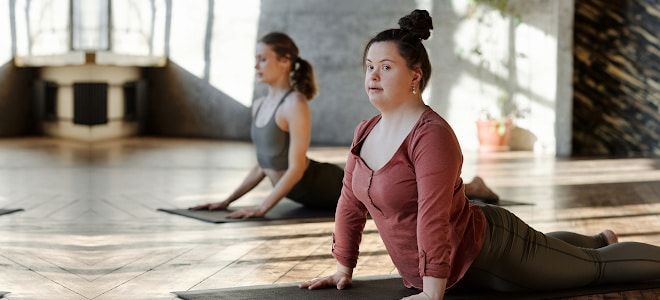
Lie on your belly on the floor and turn your head to rest your right cheek on the floor. Pause here and rest. Notice how it feels when you inhale and your diaphragm pushes against the floor. This is both calming to the nervous system and it encourages blood flow into your lower belly. From here, bring your head back to center and bring your palms to the floor next to your rib cage. Start to draw your lower ribs together, so you are slightly engaging through your upper belly to protect your lower back. Then press firmly into your hands. Lift your head, chest, and maybe your belly all the way up off the floor, straightening your arms but being careful not to hyperextend your elbows. You want to keep that control in your ribs and also squeeze your glutes to protect your lower back. Think of these points as anchors on opposite sides of your abdominal muscles moving away from each other so those muscles can stretch. Notice if this stretch feels gentle or intense. Having a tight or rigid abdominal wall can constrict blood flow and impede digestion. As with all things in the body, having balance is best. We want some tension in the belly for support and strength, but we also need flexibility and movement. After you’ve held this pose for a few breaths, slowly lower back down and rest your left cheek on the floor.
Reclined Butterfly Pose

As it relates to digestion, this relaxing pose is one where we bring our hands to our stomach and make a physical connection almost like we are honoring the amazing work that takes place in our belly. Roll onto your back and bring the soles of your feet together in butterfly pose. If this hurts your back, place a rolled towel under your hips or lower back. Place your right hand on your heart and your left hand on your stomach. Close your eyes, relax and breathe deeply. Imagine the beautiful process that takes place from hunger, to eating, to digestion, to elimination, all the way to the absorption of nutrients into our cells. Be aware of how it feels to be relaxed and calm as your body shifts into that “rest and digest” state. Know that you can come to this same state even by just closing your eyes and breathing any time. Trust that your body will remember. After you’ve held this pose for a few minutes, extend your arms and legs comfortably on the floor and rest.
Eating Meditation
Lastly, you can practice this eating meditation, shared by Cynthu Muthusamy.
Sometimes the most effective way to aid our body in its processes can be found in the simple practice of presence. Acknowledge all the raw ingredients of your meal before beginning to cut and cook them, recognizing the prana or life force energy that exists in each component of your food.
Once you are ready to eat, take a moment to receive your meal through sight and smell, taking time to express gratitude in any way that feels authentic to you. The depth of the meditation is during the actual process of eating. Enjoy your entire meal in silence without any distractions. Turn off the television, turn off the music, and avoid idle chatter with your companions. This meditation allows us to notice all of the senses that are activated with each bite of nourishment. It reminds us to be present with the first step of the physical digestion process, receiving this delicious food into our bodies!
Footnote: Yoga and the practices of asana and pranayama are not the only ways that the Whole30 is influenced by Indian knowledge and resources. As a health and wellness brand focused primarily on food, Indian influence is constantly present on our tables and in our lives. We deeply grieve the health crisis and loss of life in India today and will be donating to Breathe India in coordination with the SaveLife Foundation to support their relief efforts at the time of this blog publication.
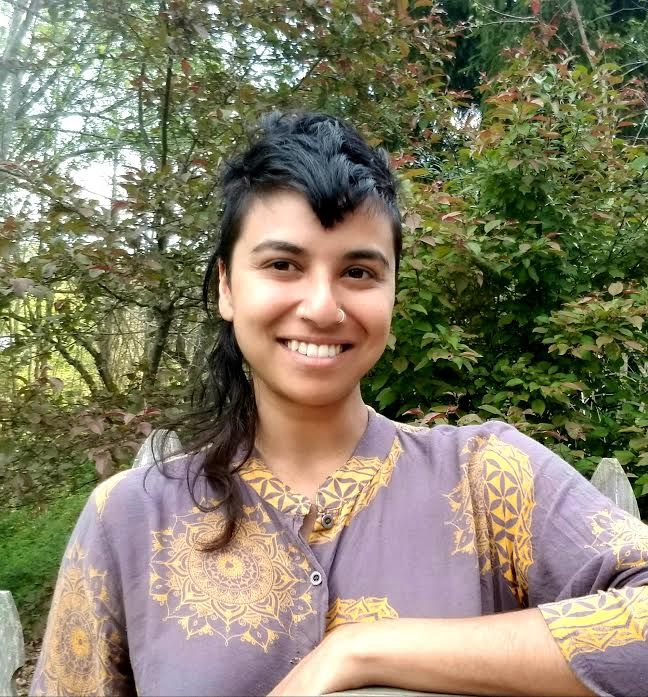
Cynthu Muthusamy (they/them) is a first generation American from South India who currently lives in the mountains outside of Asheville, North Carolina. After growing up between the Northeastern United States and Tamil Nadu, India, Cynthu took to the Appalachian Mountains to explore their own artistic expression, the wisdoms of this Earth, and opportunities in expressive therapy. Their current occupations involve expressive and behavioral therapy with adults with varied abilities, peer support facilitation for transgender and nonbinary humans, education in diversity and inclusivity, as well as massage therapy. Cynthu’s interests involve yogic science, ayurveda, expansion in gender and sexuality, and post-colonial psychology.



